
This year a lot of my work as Visiting Scholar at the David and Lucile Packard Foundation is working with grantees outside of the US. I’ve just returned from leading a training for Population and Reproductive Health grantees from India. This was the launch of a peer learning group called “The Networked NGO,” based on the ideas in my book, The Networked Nonprofit. The four-day intensive face-to-face training was for senior level staff and their social media staffers. It marked the start of a six month peer learning exchange where I, along with colleague Stephanie Rudat will work remotely with grantees as they implement an action learning project to put techniques into practice and facilitate organizational change from the inside out.
We are working very closely with V.S. Chandrashekar, India Country Advisor and his talented team members, Ms. Anupam Shukla and Ms. Monica Wahengbam.
This blog post includes some reflections on the instructional design, delivery, and insights that I hope will inform the field building discussion taking place over at the Packard OE Program site.
1. Program Design

The program design is based on the last six years of delivering social media training sessions and incorporates refinements that I’ve learned a long the way. I have designed and delivered trainings that were short-term, one-time sessions such as a half-day or full-day workshop to more intensive programs that incorporated face-to-face, peer exchange, action learning projects, and monthly meetings that took place over a six-month period. The value of doing an extended peer learning exchange is that participants get the opportunity to put the ideas in practice and apply what they learned.
Typically, during a workshop or training with heavy-content delivery (such that is required with technology) the workshop leader or teacher is providing support around “ready” and “set” phases or what we call planing and strategy as well as best practices. The peer learning sessions that follow focus on the “go” – that’s when the workshop leader becomes more of a coach as the participants actually use what they’ve been taught and compare notes with their peers. I feel the learning is richer and more sticky. Peer exchanges help participants not only form good habits, but they also naturally start to collaborate and work in a networked way.
When you design a capacity building project based on peer learning and is focused on topics that will require transformative organizational change to apply skills and knowledge, it is important to have a realistic and clear idea about what constitutes success. Not thinking this through at the beginning can spell disaster, especially if there are unrealistic expectations and you are working in places where connectivity is a barrier.
This project has identified the following definitions of success:
- A Peer-to-Peer Learning Exchange
Grantees will engage in peer discussions about integrating social media effectively into their communications strategies and will learn from each other – from challenges and missteps as much as from accomplishments and wins – so success means organizations sharing both.
- Networked NGOs and Social Media Integrated Into Organizational Communications
Through the 4-day workshop in-country and subsequent online and conference calls, grantee organizations will start to embrace the practices of Networked Nonprofits and begin to institutionalize social media strategies and integrate them into their broader strategy for communications on population and reproductive health or girls and girls and women’s empowerment.
- Grantees Implement A Modest and Realistic Action Learning Pilot
Social media practices are just that – they get strong and stay strong with practice – so success means consistent application and learning. With facilitator’s guidance, grantees will design and implement a small action learning project. But smart is as important as strong, so success also means deliberate integration of social media strategies with the organization’s broader communications plan and learning from doing in small steps.
- Purposeful Measurement to Inform Replication
Grantee organizations will measure what matters. Social media can be filled with metrics to track results. But not all metrics are equally valuable, and choosing the measurements that matter can be complicated. Even more importantly, the practice of connecting measurement and decision-making will help organizations improve practice and results, and document value. Success means using metrics to learn how to improve practice effectively, both to identify obstacles and track progress. The action learning project will be designed to help grantees build a habit of measurement, reflection, and organizational learning.
These definitions have informed the curriculum, instructional design, peer learning design, and how we will measure and learn along the way. The specific indicators of program success are below and were identified with input from participants:
- 100% of participants will develop an integrated and measurable social media strategy that furthers their communications work in population and reproductive health that aligned with institutional goals
- 100% of participants implement a process and write a social media policy that addresses organizational adoption issues
- 100% of participants implement an action learning project that uses measurement to help improve their practice, share insights with peers, and identify opportunities to amplify each other’s voices through social media
The four-day workshop has a different theme for each day as follows:
Day 1: The Power of Networks
Day 2: Integrated Social Media Strategy
Day 3: Practical and Tactical Social Media
Day 4: Action Learning Projects, Communicating After Workshop, and Managing Our Attention
2. Participants Own Their Learning
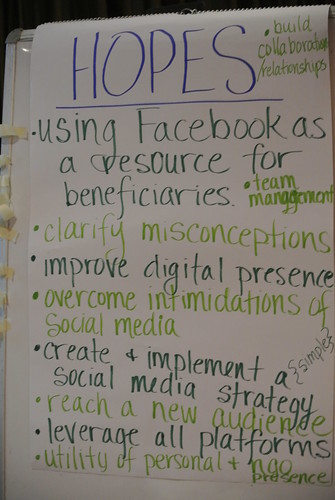

It’s one thing for an instructor to let participants know what the intended outcomes and learning objectives are for a training, but for true impact participants need to own their learning agenda. One technique that I learned from Cheryl Francisconi, director of the IIE Addis-Ababa Office in Ethiopia, last month in Rwanda, was to allow time and space for participants to articulate their hopes and fears. The beauty of this exercise is that it allows for any concerns or skepticism to be voiced and honored. I was amazed at the transformation in the room during the first day – from health skepticism of social media to seeing its value and importance as integrated communications strategy.
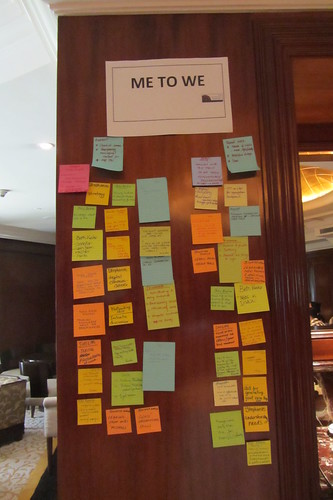

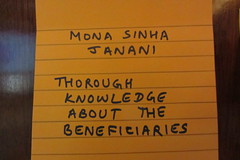
3. Learning Networks Are Built With People and Reciprocity
While the training was geared for organizations to become “networked ngos,” it is important to recognize that networks consist of individuals and organizations. Also, networked learning or peer learning is a person-to-person learning and therefore it is important to establish connections and points of reciprocity during the face-t0-face session. One of my favorite introductory exercises, is to to build a “ME to WE” network based on individuals knowledge and what they hope to learn. The exercise helps people get to know each other as a professionals, plus it is another example of visualizing a network with sticky notes. It works best when you are working with a group of participants who work in the same field and may already know each other.

We also use it an opportunity for participants to get on Twitter as an individual and how to use it as a personal professional learning and branding tool. In India, the line between personality and brand is not strict as it is in the US – and the identities can be fluid. We demonstrated and showed how Twitter can be used to connect with colleagues and extend a brand or campaign. We encouraged participants to Tweet their reflections using the hashtag we set up for the group. And, how to connect with colleagues in their field. This is something that nonprofit professionals are just beginning to explore.
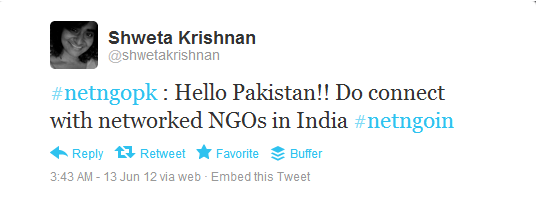
4. Replicating Networking on the Ground Online and Connecting to Strategy
The central thesis of the Networked Nonprofit is that nonprofits should work more like networks than isolated institutions. After we create a shared network based on individual’s knowledge and skills, we move to the organizational network maps. Participants create a poster of their networks, view other the network maps of others, and then do a debrief. The exercise usually takes 90-120 minutes in the afternoon, but participants were so engaged they didn’t want to stop for tea. The big ah ha after viewing the maps on the wall next to each other is that these NGOs had strong and vibrant networks established on the ground. As Pushpa from GuideStar India remarked, “It is very exciting to see the potential of seeing our NGOs become as connected online and through social networks because it can help us accelerate change.”

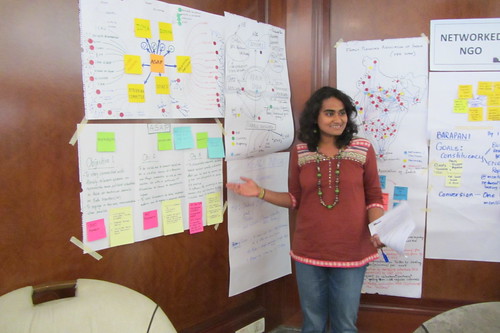
On Day 2, we take a deep dive into understanding how to develop an integrated social media strategy, beginning with an exercise that helps participants really define what success means. Many nonprofits are so quick to jump into the tactical of social media and skip over defining success. One of the most important lessons I’ve learned from working with KD Paine on my next book, “Measuring the Networked Nonprofit” is the important of defining success. We devote an entire chapter to it and the workshop exercise is based on this chapter.
The morning also includes sharing the principles of successful social media, a talk that I have been giving and refining over the past 5 years and changes with new trends and developments in social media. We also do a session of with case studies from the participants country or subject matter area. The case studies method allows participants to identify best practices and collect ideas for their strategy. The morning culminates with work on the strategy, identifying goals, SMART objectives, audience, and how to measure. These are done as posters and placed side-by-side to network maps. This was the first time I had intentionally had participants place both together on the wall and seeing these visually connected made for a more insight discussion.

The afternoon of Day 2 on strategy is focused on strategic web presence and integrated content strategy, with an introduction to content curation. I used the “Fishbowl” technique for an exercise to help participants experience what it is like to brainstorm ideas for an integrated content strategy. Four participants sit in the center and use sticky notes and a strategy template to generate ideas for content for different channels. Anyone observing can tap someone in the shoulder replace them in the inner circle. Since participants were from organizations working on similar content areas, this helped everyone.
5. The Importance of Energizers Throughout
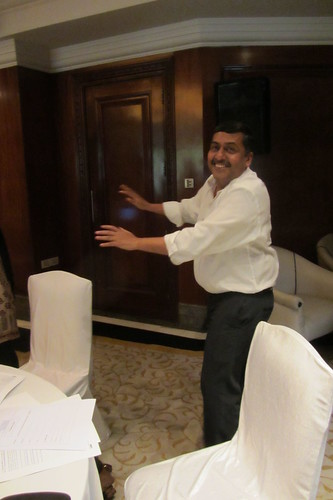
I strongly believe that people should not be left in sitting their seats with their laptops open for a training for more than 30 minutes at a stretch. It puts people to sleep and it isn’t very healthy. When I present content, it is done in an active way – participants get to move around, stand up, walk around, and move. Moving gets blood to the brain, getting blood brain helps people take in new ideas. We also did fun and creative after lunch energizers. On the first day, in honor of being in India, I played a YouTube video of a well-loved Bollywood number called “Chaya, Chaya.”
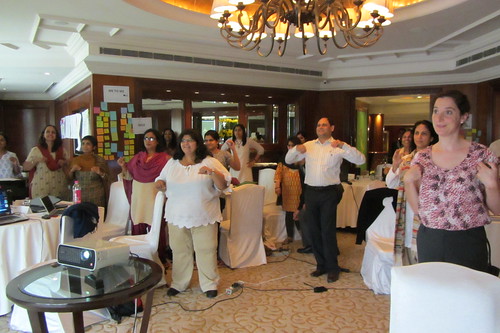
After a lunch on Day 2, we shared an American classic dance, the Chicken Dance.

We held the training in a beautiful hotel in Delhi, The Claridges, which had a double three floor staircase. We made people go up and down the stairs three times before settling in after lunch.

6. It Isn’t Enough To Tell People About Best Practices: Hands-On, Brains-On
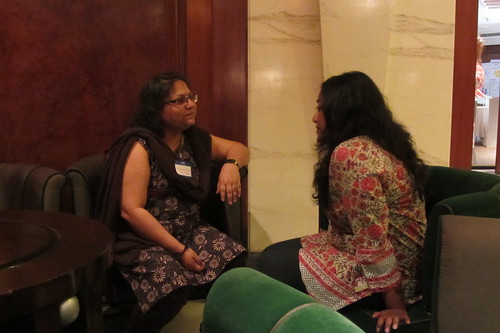
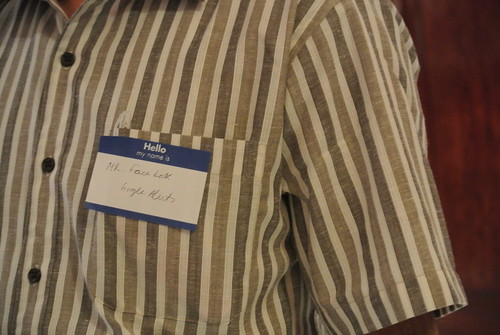
On Day 3, we covered the best practices of using listening, Twitter, and Facebook, with ample time to practice. I always begin with an orientation exercise that allows participants to draw from their own knowledge of what they already know and what they want to know about the tools. This is important because there is so much to learn and it can get overwhelming. I do a variation of “speed dating,” each person creates a name tag with a first name and last name the name of a platform or tool they know about or have questions about. Then each person gets to speak with another participant for 7 minutes and we do 6 or 7 rounds of speed dating.
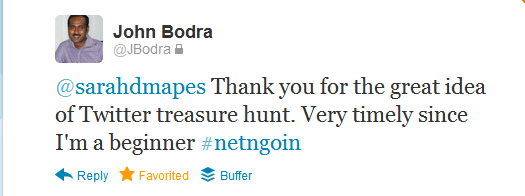
We integrate both the best practices and hands-on activity. Moving from telling, showing, discussing and to actual hands-on practice. Typically, the practice activities are not just the boring set up steps of the platform, but setting up people’s networks. I was inspired by a technique used by Sarah Mapes in Colorado for new Twitter users that makes it fun for them. I wrote about the practice of Team Tweeting here. Using this concept, we set up Twitter scavenger hunts to explore lists and users in the reproductive health field as well as to practice tweeting.
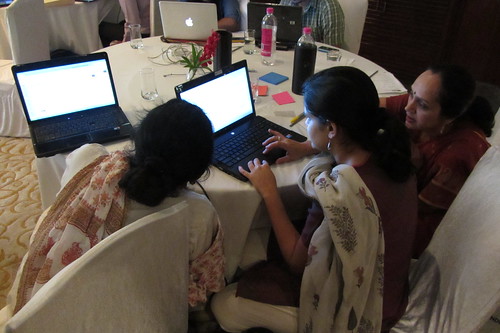
When integrating hands-on, I use a technique called “Laptops Up/Laptops Down” – so when it is laptops up time, it is time for participant to practice their skills together. I encourage social learning together as I have observed many young people – this helps transfer knowledge. I ask for “Laptops Down” when I need the group to give their attention to the screen or to debrief the skill. When participants were working on practicing skills on the wiki or Facebook group, the platforms we will use to communicate after the session, we did a walking around debrief so participants share what they did on their own laptop. This keeps the training active and helps people attend to the learning.
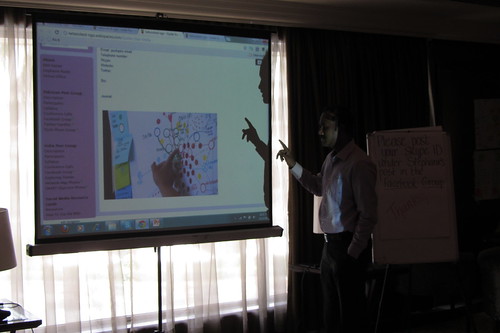
Since we are trying to build a network of learners, it is very important to encourage participants to be the leaders and teachers. In some of the debriefs, I have a participant lead the debrief or instruction. Once the “teacher” steps aside, the participants are often very capable to teaching each other. This is the holy grail of a peer learning group – one that builds it knowledge and share it and is not reliant on the “expert.”
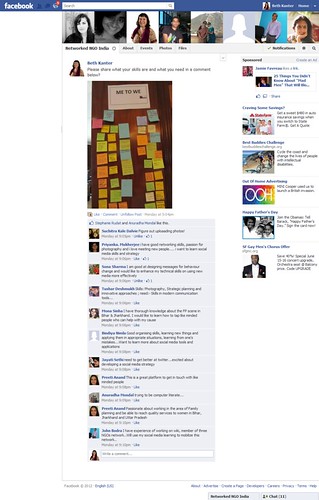
To support participants during the 6 months following the workshop in their action learning projects, we use several platforms – private Facebook group, webinar, and conference call. I learned that while Webinars and conference calls are very familiar to many people in the US, it is not a common in other places in the world. That’s why we do a lot of practicing of the conference call platform – we hold a mock conference call and debrief the experience. We also have participants dial into the webinar platform for a section of training and debrief in the Facebook Group.
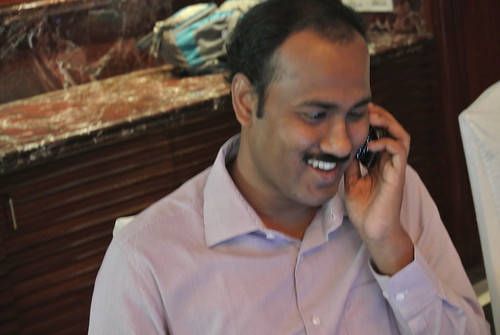
7. Closers to Consolidate Learning

Closers are essential to helping participants consolidate their learning and make a commitment to continued practice. I have people do silent reflection on sticky notes and I also do a closing circle – and have each person pass an object and speak briefly. I learned this technique from Cheryl Francisconi, director of the IIE Addis-Ababa Office in Ethiopia, last month in Rwanda,who uses a stone that has been held by many people. I improvised and had participants pass around a flower. Someone remarked that we have invited the “Flower Mic”
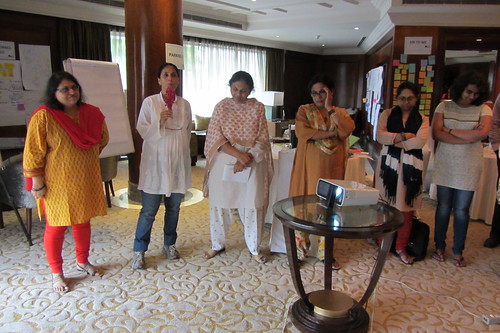
Finally, each participants receives a certificate, books from a colleague, and a gift of chocolate from San Francisco!

All in all, a very exciting launch to a peer learning exchange. Following the session, participants mentioned that they found it very engaging, were not bored, and did not fall asleep after lunch. The proof will be at the end to see how participants do against measurable objectives. So stay tuned.
Designing effective training is a both a science and an art form, what was the most effective training you attended and why?
